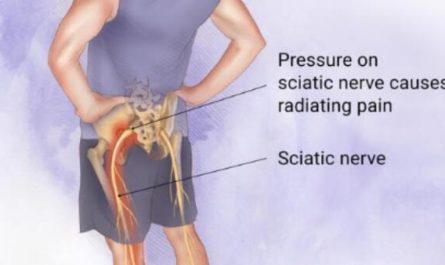Shoulder pain radiating down the arm can be a debilitating issue. It can interfere with daily activities, normal movement, and even sleep. The pain usually appears on the outside of the shoulder that may radiate further down your arm or elbow.
Injury is the most common cause of this type of pain. It can be caused by a sudden event such as a fall or an awkward movement, or it can result from repetitive strain from activities such as sports or work.
In some cases, the pain can be traced to a rotator cuff tear, bursitis, or a dislocation. Another cause of shoulder pain radiating down the arm is arthritis. This can be either osteoarthritis or rheumatoid arthritis. Other conditions such as angina, thoracic outlet syndrome, or a heart attack can also lead to pain radiating down the arm.
If you suffer from a fall or significant injury, you should see your doctor immediately.
What Is A Trapped Nerve?
Another common cause of radiating pain may be a ‘trapped’ or ‘pinched’ nerve. This problem can cause tingling, numbness, and shoulder pain that radiates down your arm.
A trapped nerve is a non-scientific term used to describe the pressure exerted on a nerve by either bone, soft tissue, or a herniated disc; if you’re suffering from a trapped nerve, it’s essential to understand the causes as well as any potential treatment options available.

Pinched Nerves: Causes of Shoulder Pain Radiating Down Your Arm
There are two common causes of pinched nerves: degenerative changes through aging or injury.
Your spinal column consists of 24 bones stacked on each other, called vertebrae. The cervical spine contains seven small vertebrae that begin at the skull base and form the neck.
The job of the spinal column is to protect your delicate spinal cord. The spinal cord comprises electrical cables that carry signals up and down the body of a human being’s control center.
As our body ages, the vertebrae in our spine shorten and swell, drying out in the process. As the length of the vertebrae shortens, they move closer to each other. The body reacts by forming extra bone to reinforce the region around the disc, often trapping nerve endings in the process.
This degenerative process is often called arthritis and is usually not cause for alarm. Arthritis is a common occurrence in an aging body and, for the most part, will affect nearly everyone in their lifetime. Rest assured that worn discs occur in almost half of the middle-aged population, and for most, they cause few issues.
In younger patients, a herniated disc is usually a result of injury associated with awkward movements, such as lifting objects that are too heavy. Here, the center of the vertebrae pushes against the outside of the disc. This process puts external pressure on the nerve ending, which causes discomfort and weakness in the area.
Typical Symptoms of Pinched Nerve
The common symptoms of a pinched nerve include shoulder pain or electrical ‘shooting’ sensations down the arm. They can consist of muscle weakness, numbness, aches, or tingling sensations (pins and needles).
The severity of the pain varies based on the location and cause of the trapped nerve. A common complaint from some patients is waking up with a sore or ‘frozen’ neck.
A pinched nerve usually only causes pain in one shoulder. Often, it’s a sharp pain instead of a dull ache or discomfort similar to that you may experience when you’ve overworked your muscles.
Tests the Shoulder Pain Radiating Down Your Arm at Home
Before visiting a medical professional, you can conduct a few easy-to-do tests at home to self-diagnose the issue. Please remember that these tests do not replace a medical diagnosis, and you should always discuss with a qualified medical practitioner to obtain an accurate diagnosis.
Test 1: Neck Stretching
This test will determine whether relieving tension on the nerve reduces or relieves your symptoms.
First, tilt your head to the side so it does not cause discomfort. Hold your head in this position for a minute or two, stretching the neck muscle with your other arm.
Does this relieve your symptoms, including a reduced sense of numbing or warming sensation in the arm? If yes, move on to test 2.
Test 2: Arm Tension
First, establish your normal range of movement by taking this test with your non-painful arm.
Holding your arm out in front of you, rotate your palm outward to face away from your body. Slowly move your arm to the side, as far as it comfortably goes.
Using the arm causing you discomfort, repeat the process. If you notice increased symptoms, decreased range of movement, or pain, stop the exercise and move on to test 3.
Test 3: Neck Compression
Starting again with the side that is not causing you pain, turn your head to one side so your ear almost touches your shoulder. Rotate your head slightly, look backward over your shoulder, and hold for a minute. Once complete, reperform the test on the painful side.
If you feel any pain radiating down your arm, an increase in numbing or tingling, move on to the final test.
Test 4: Turning your head
Turn your head to the side that is not painful and hold it there for a few seconds. You shouldn’t notice any restricted movement or pain. Next, turn your head in the opposite direction and hold for a few seconds. If you experience restricted movement or an element of pain radiating down your arm, then you have a positive result for this test.
If you have gone through each test and reached the end, you are likely suffering from a trapped or pinched nerve. The next step is to gain a comprehensive diagnosis from a medical practitioner.
How Is It Diagnosed?
As with any potential medical issue you face, you should always seek the advice of a qualified medical professional. If a pinched nerve causes your shoulder pain, you will need a thorough physical examination of your neck and shoulder to diagnose the issue.
A spine specialist usually identifies the issue by assessing your symptoms and a thorough physical exam. The doctor can also examine your reflexes.
As part of the process, it is usual practice for your doctor to ask you to perform specific movements designed to cause you discomfort. Allowing your doctor to see what is causing you pain will lead to a quicker and more accurate diagnosis.
Imaging Tests
After a physical examination, various additional tests could be conducted. An x-ray will typically be taken to look at the structure of your bones – specifically your spine. This is useful to determine any misalignment of the vertebrae, one of the signs of a trapped nerve.
A CT scan may be more appropriate, which is much more detailed than a traditional x-ray. A CT scan is beneficial when determining whether an extra bone has been formed in your spine.
An EMG scan (electromyography) can detect the electrical signals in muscles when resting and through exertion. It can be used to diagnose irregular nerve functions. It can be used to rule out other problems that affect the nerves, including diabetes.
An MRI scan is fantastic at analyzing internal soft tissues. Although daunting, MRI scans will allow a doctor to detect whether your pain is caused by damage to the soft tissue in your spine. It is also helpful to determine any damage to nerve endings or your spinal column.
Treatments For Shoulder Pain Radiating Down Your Arm
Thankfully, many patients who suffer from trapped or pinched nerves go on to recover fully and do not need any form of treatment.
In most cases, pinched nerves usually get better without surgery, and some don’t require treatment. In the most extreme circumstances, your doctor may conclude a formal treatment plan, which can exist in various forms.
1. Ice application
Ice application is an effective home remedy that can help reduce inflammation and pain and prevent swelling in the affected area. You can wrap some ice with a cloth and apply it to the shoulder and arm region. Ensure you don’t place ice cubes directly on the skin, which will hurt the skin.
2. Medication
Doctors will often do all they can to avoid prescribing medication. Still, in some cases, it is the most appropriate option. There are two most common groups of medicines doctors will often diagnose to treat pinched nerves:
- Anti-Infammatories: This includes common over-the-counter medications designed to reduce inflammation and relieve pain.
- Corticosteroids: Another medicine that reduces inflammation, a short course of this oral medication can help alleviate some of the underlying symptoms of trapped nerves.
3. Physiotherapy
Physiotherapy using prescribed exercises can reduce pain and firm up the underlying muscles that support the neck. It is also important in recovery, and we will discuss this later.
4. Foam Neck Collar
You will probably be familiar with this treatment as it is evident and often used to treat whiplash injuries for those involved in car accidents.
The padded foam material is wrapped around the neck and secured with Velcro. This device allows the muscles in your neck to rest, reducing the burden of the head on the underlying vertebrae. The result can decrease any pinching or trapping of nerves in the cervical spine.
Such collars should only be worn for short periods to prevent any long-term effects on the muscles in your neck, so please follow the guidance of your doctor.
5. Steroid Injections
Steroids are an effective treatment for trapped nerves. When injected around the area concerned, the steroid can reduce inflammation. The goal is to minimize the swelling long enough so the nerve can recover, providing long-term relief.
6. Surgical Treatment
Having worked through several other options, surgical intervention may be recommended if your case is adequately severe.
Depending on the severity of your situation and any underlying health conditions, various surgical procedures are available to you. Your doctor will thoroughly assess your case, and a recommendation made as to the most appropriate treatment.
When to See Your Doctor
There are severe symptoms that you should see a doctor immediately.
- Severe pain due to injuries such as fractures or dislocations
- Pain cannot be relieved after simple treatment at home
- Pain lasts for a long time or even painful at night
- Severe swelling or redness appears around the pain area
- Unexplained pain or you wonder it is the symptoms of a heart attack
Surgical Risks
As with any form of surgery, there are associated risks you should be aware of before undergoing treatment. Thankfully, the chance of any severe complications is low. Still, it would help if you always went into surgery with an understanding of the potential risks.
Potential risks include:
- Further nerve injury
- Excessive bleeding
- Infections
- Further injury to the spinal column
- Adverse reaction to anesthetics
- Nerve sac damage
- Life-threatening complications with the heart or lungs
- Strokes
Recovery Time
You will usually stay in the hospital for a day or two post-surgery. However, this varies depending on the surgery you have undergone. In usual cases, eating and walking are possible the day after surgery. Still, it’s normal to feel discomfort swallowing for a few weeks after surgery.
To help the healing process, you may need to wear a foam collar to alleviate some of the pressure on your neck vertebrae. If you have undergone spinal fusion, your body may take up to a year to fully recover while the bones solidify.
You may need certain restrictions to prevent further complications, such as avoiding strenuous activities like lifting heavy objects or intense workouts. Light exercise, such as walking, is excellent and is essential to rebuild your muscle strength.
Post Surgical Physiotherapy
After a sufficient healing time, you will usually need to perform a daily strength-building routine. It’s essential to stick to this to speed up recovery time. Physiotherapy will typically include some basic movements you can do at home with the guidance of a professional.
When Can You Return To Work?
If you suffer from shoulder pain radiating down your arm, you can return to light duties (including desk-bound jobs) a few days or weeks after surgery, depending on the severity. Usually, patients can resume their full daily routine after a few months. This should always be done on your doctor’s advice to avoid complications.
All being well, most patients experience a complete and favorable outcome after surgery. With pain and other symptoms subsiding, most patients can lead a full life.






